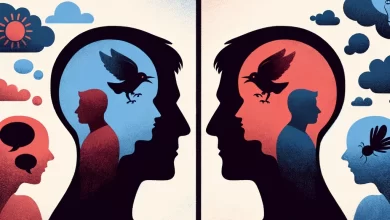Understanding Anxiety Symptoms in Daily Life
Do you ever find yourself constantly worrying and feeling on edge? Have you experienced sudden bouts of fear or panic that seem to come out of nowhere? These could be signs of anxiety, a common mental health condition that affects millions of people worldwide.
Anxiety disorders can manifest in various ways, from physical symptoms like increased heart rate and sweating, to emotional responses such as excessive worry and fear. Understanding the symptoms of anxiety can help you recognize when it’s more than just everyday stress and take steps towards managing it.
Key Takeaways:
- Anxiety symptoms can vary and may include both physical and emotional signs.
- Recognizing the symptoms of anxiety is crucial in seeking proper diagnosis and treatment.
- Anxiety disorders can significantly impact daily life and functioning.
- Managing anxiety often requires professional help and a personalized treatment plan.
- Don’t hesitate to reach out for support if you’re struggling with anxiety.
Different Types of Anxiety Disorders
Anxiety disorders are a broad category of mental health conditions that can manifest in various ways. Understanding the different types of anxiety disorders is essential for recognizing their symptoms and seeking appropriate treatment. The main types of anxiety disorders include:
- Generalized Anxiety Disorder (GAD): This is characterized by persistent and excessive worry and fear about everyday events and activities. Individuals with GAD often struggle to control their anxiety, which can interfere with their daily functioning.
- Social Anxiety Disorder (SAD): SAD is marked by an intense fear of being scrutinized or judged by others. People with SAD may avoid social situations, leading to feelings of isolation and distress.
- Panic Disorder: Panic disorder is characterized by recurring panic attacks, which are sudden episodes of intense fear or discomfort. These attacks can be debilitating and often lead to a fear of future attacks and avoidance of certain places or situations.
- Specific Phobias: Specific phobias involve an intense fear of specific objects, situations, or activities. Common examples include fear of heights, spiders, or flying. Individuals with specific phobias may go to great lengths to avoid their triggers.
- Separation Anxiety Disorder: This type of anxiety disorder is commonly seen in children but can also affect adults. It involves excessive anxiety when separated from a specific person or place, often causing significant distress and impairment in daily life.
While each type of anxiety disorder has its own unique characteristics, they all share the common feature of causing significant distress and interference with daily functioning. Seeking professional help is essential for diagnosis and effective management of these disorders.
Symptoms of General Anxiety Disorder
Generalized anxiety disorder (GAD) is a common mental health condition characterized by excessive worry and fear. This chronic condition can significantly impact an individual’s daily life. Understanding the symptoms of GAD is essential for early detection and effective management.
Some of the most prevalent symptoms of general anxiety disorder include:
- Excessive Worry: GAD often manifests as persistent and uncontrollable worrying about various aspects of life, including work, relationships, health, and finances.
- Muscle Tension: People with GAD may experience muscle tension, which can cause discomfort or pain in the neck, shoulders, jaw, or back.
- Fatigue: GAD can lead to constant feelings of fatigue and exhaustion, even after getting enough sleep.
- Difficulty Concentrating: Individuals with GAD may struggle to focus or maintain attention, making it challenging to perform well in tasks that require concentration.
- Irritability: Anxiety can heighten irritability and make individuals more prone to becoming easily agitated or frustrated.
- Sleep Disruption: GAD often interferes with sleep patterns, causing restless nights, difficulty falling asleep, staying asleep, or having frequent nightmares.
It’s important to note that everyone’s experience with GAD may differ, and symptoms can range in severity. If you or someone you know is experiencing these symptoms, it’s crucial to seek professional help for a comprehensive evaluation and appropriate treatment.
“It is normal to feel anxious in certain situations, but when anxiety becomes excessive and uncontrollable, it may be a sign of generalized anxiety disorder. Recognizing the symptoms and seeking proper care can make a significant difference in managing this condition and improving overall well-being.”
Professional quotes:
“Symptoms of generalized anxiety disorder can vary from person to person. However, excessive worry, persistent muscle tension, fatigue, difficulty concentrating, irritability, and disrupted sleep are some common manifestations. Seeking professional help is crucial in understanding the root causes and developing effective coping mechanisms.” – Dr. Jane Thompson, Psychologist
Treatment options:
It is important to remember that these symptoms can be effectively managed and treated. A combination of therapy, such as cognitive-behavioral therapy (CBT), medications, such as selective serotonin reuptake inhibitors (SSRIs), and self-care techniques, including stress management and relaxation exercises, can significantly alleviate the impact of general anxiety disorder on daily life.
| Treatment options for General Anxiety Disorder |
|---|
| Cognitive-Behavioral Therapy (CBT) |
| Medications (e.g., SSRIs) |
| Relaxation Techniques |
| Stress Management |
Signs of Social Anxiety Disorder
Social anxiety disorder (SAD) is a common mental health condition characterized by an intense fear of being judged or embarrassed in social situations. Individuals with SAD often experience self-consciousness and have a strong desire to avoid social events and interactions. This fear and avoidance can lead to significant distress and impairment in various areas of life.
One of the signs of social anxiety disorder is a persistent fear of being negatively evaluated by others. The fear of being judged can be overwhelming and may cause individuals to constantly worry about saying or doing something embarrassing in social settings. This fear often leads to self-consciousness and a heightened awareness of one’s actions and appearance.
People with social anxiety disorder tend to avoid social situations or endure them with intense fear or distress. They may have difficulty initiating or maintaining conversations, participating in group activities, or speaking in public. This avoidance behavior can impact their personal relationships, academic or professional performance, and overall quality of life.
In addition to the psychological symptoms, social anxiety disorder can also manifest through physical symptoms. Common physical symptoms of social anxiety disorder include sweating, trembling, blushing, rapid heartbeat, and stomach discomfort. These physical manifestations are a result of the body’s natural response to stress and can further contribute to the individual’s self-consciousness and fear of being judged by others.
Recognizing Signs of Social Anxiety Disorder:
- Excessive fear of being judged or embarrassed
- Intense self-consciousness
- Avoidance of social situations and interactions
- Physical symptoms like sweating and trembling
If you or someone you know experiences these signs, it is essential to seek professional help. Social anxiety disorder is a treatable condition, and there are effective therapies and strategies to manage and overcome these symptoms. With the right support, individuals with social anxiety disorder can improve their social interactions and lead fulfilling lives.
Understanding Panic Disorder
Panic disorder is a type of anxiety disorder characterized by sudden and intense feelings of fear, often referred to as panic attacks. These panic attacks can occur unexpectedly and are accompanied by physical symptoms like heart palpitations and shortness of breath.
Panic attacks can be terrifying experiences, causing individuals to feel like they are losing control or even facing imminent death. The physical symptoms, such as a racing heart and difficulty breathing, can be extremely distressing.
Individuals with panic disorder often develop a fear of future panic attacks, leading to avoidance of certain situations or environments that they associate with previous panic episodes. This can impact their daily lives, causing limitations in activities they once enjoyed or frequent disruptions in their routine.
To better understand panic disorder, it’s important to recognize the common physical symptoms that accompany panic attacks. These may include:
- Heart palpitations or accelerated heart rate
- Shortness of breath or a feeling of suffocation
- Dizziness or lightheadedness
- Trembling or shaking
- Sweating
- Nausea or stomach discomfort
- Chest pain or discomfort
While panic disorder can be debilitating, there is hope for individuals who experience these intense episodes of fear. Seeking professional help from a therapist or psychiatrist who specializes in anxiety disorders can provide guidance and support in managing panic attacks. Treatment options may include cognitive-behavioral therapy (CBT), medication, or a combination of both.
With the right treatment and support, individuals with panic disorder can learn effective coping mechanisms and regain control over their lives. Remember, you are not alone, and help is available to help you on your journey to managing panic disorder.
| Physical Symptoms of Panic Disorder | Emotional Symptoms of Panic Disorder |
|---|---|
| Heart palpitations | Fear and intense dread |
| Shortness of breath | Worry about future panic attacks |
| Dizziness or lightheadedness | Difficulty concentrating |
| Trembling or shaking | Irritability or restlessness |
| Sweating | Feeling detached from oneself or reality |
Specific Phobias and Anxiety
A specific phobia refers to an intense and irrational fear of specific objects or situations. This fear goes beyond the normal level of discomfort and can cause significant distress in individuals. Those who suffer from specific phobias often experience avoidance behavior, going to great lengths to avoid encountering the object or situation that triggers their fear.
Their fear response can be triggered by various stimuli such as animals, natural environments, heights, blood, or certain social situations. For example, someone with a specific phobia of spiders may go to great lengths to ensure they never come into contact with spiders, even if it means rearranging their life. This avoidance behavior can severely impact their daily lives, causing them to miss out on opportunities or experiences.
The fear experienced by individuals with specific phobias is often accompanied by physical and emotional symptoms. These symptoms can be similar to those experienced in general anxiety disorders, such as increased heart rate, sweating, trembling, and difficulty breathing. Panic attacks can also occur when confronted with the specific phobia, leading to intense feelings of fear and a strong desire to escape the situation.
“When I see a snake, I immediately feel my heart racing, my palms sweating, and an overwhelming sense of fear washes over me. I just want to run away as fast as I can,” explains Sarah, who suffers from a specific phobia of snakes.
Common Types of Specific Phobias
Specific phobias can encompass a wide range of fears and phobic reactions. Some common types of specific phobias include:
- Fear of animals such as spiders, snakes, or dogs
- Fear of natural environments like thunderstorms or heights
- Fear of blood or medical procedures
- Fear of certain social situations, such as public speaking or eating in front of others
These specific phobias can vary in their intensity and the impact they have on daily life. For some individuals, the fear may be manageable and only cause mild discomfort. However, for others, the fear can be debilitating, leading to significant distress and impairment in their functioning.
| Specific Phobia | Symptoms |
|---|---|
| Arachnophobia (Fear of Spiders) | Rapid heartbeat, sweating, trembling, panic attacks, avoidance of areas with spiders |
| Aerophobia (Fear of Flying) | Panic attacks, hyperventilation, nausea, avoidance of air travel |
| Astraphobia (Fear of Thunderstorms) | Increased heart rate, sweating, rapid breathing, hiding indoors during storms |
| Trypanophobia (Fear of Needles) | Panic attacks, avoidance of medical procedures, fainting, intense anxiety |
These examples illustrate how specific phobias can create intense anxiety and avoidance behaviors in individuals, impacting their quality of life. Seeking professional help and treatment can be crucial in managing specific phobias and improving overall well-being.
Separation Anxiety and its Impact
Separation anxiety disorder is a condition characterized by excessive anxiety when separated from a person or place that brings feelings of safety. This type of anxiety can be particularly challenging, as it often manifests in children but can also affect adults. When individuals with separation anxiety disorder are separated from their loved ones or familiar environments, they may experience intense fear and worry.
The impact of separation anxiety can be significant, affecting various aspects of daily functioning. When separated from the person or place they are attached to, individuals with separation anxiety may experience panic attacks characterized by intense feelings of fear and discomfort. These panic attacks can include symptoms such as a rapid heart rate, chest tightness, shortness of breath, and a sense of impending doom.
Furthermore, separation anxiety can disrupt a person’s ability to participate in normal activities. For children, this may manifest as difficulty attending school or engaging in social events without the presence of a trusted caregiver. In adults, separation anxiety can interfere with work, social interactions, and the ability to travel or be away from home for extended periods.
Separation anxiety disorder can cause significant distress and impairment in various aspects of an individual’s life. It is important to address and manage this condition to ensure a person’s well-being and overall quality of life.
Management and Treatment Options
Fortunately, there are strategies and treatments available to help individuals manage separation anxiety. These can include:
- Therapy: Cognitive-behavioral therapy (CBT) can be effective in helping individuals learn coping mechanisms and develop skills to reduce anxiety when separated from their loved ones or familiar environments.
- Medications: In some cases, medications such as selective serotonin reuptake inhibitors (SSRIs) may be prescribed to help alleviate anxiety symptoms and manage separation anxiety disorder.
- Gradual exposure: Gradually exposing individuals to situations that trigger their separation anxiety, under the guidance of a therapist, can help desensitize them to the associated fears and anxieties.
It is crucial for individuals experiencing separation anxiety to seek professional help from a mental health provider who can provide a comprehensive assessment and create an individualized treatment plan. With the appropriate support and treatment, it is possible for individuals with separation anxiety to experience relief and improve their daily functioning.
| Impact of Separation Anxiety | Symptoms |
|---|---|
| Disruption of daily activities | Panic attacks |
| Difficulty attending school or work | Physical symptoms like rapid heart rate and shortness of breath |
| Impaired social interactions | Feelings of fear and discomfort |
Physical Symptoms of Anxiety
Anxiety can manifest in various ways, including physical symptoms. When experiencing anxiety, the body’s fight-or-flight response kicks in, leading to a range of physical changes and sensations. Some common physical symptoms of anxiety include:
- Increased heart rate
- Sweating
- Trembling
- Headaches
- Muscle aches
During periods of heightened anxiety, the body releases stress hormones like adrenaline, which can cause an increased heart rate. This can make individuals feel as though their heart is racing or pounding. Sweating is another physical symptom often associated with anxiety, as the body attempts to regulate its temperature in response to stress.
Trembling or shaking may also occur as a result of anxiety. This can be due to heightened muscle tension caused by the body’s stress response. Headaches can frequently accompany anxiety, as tension in the muscles of the head and neck can lead to pain and discomfort.
Similarly, muscle aches are a common physical symptom of anxiety. Stress can cause muscles to become tense and tight, leading to feelings of soreness or stiffness. These physical symptoms of anxiety can vary in intensity and duration, depending on the individual and the specific situation.
Anxiety is not just a mental or emotional experience; it can also have a significant impact on the body. Recognizing and addressing the physical symptoms of anxiety is an important part of managing this condition and promoting overall well-being.
Awareness and Self-Care: Combating Physical Symptoms
When experiencing physical symptoms of anxiety, it’s essential to practice self-care and implement strategies to alleviate discomfort. Taking slow, deep breaths can help regulate the heart rate and promote relaxation. Engaging in physical activity, such as yoga or exercise, can also help release tension and reduce muscle aches.
Additionally, incorporating stress-management techniques into daily life, such as mindfulness meditation or journaling, can contribute to overall anxiety reduction. Seeking professional support, such as therapy or counseling, can provide valuable guidance and tools for managing anxiety symptoms. Remember, you are not alone, and there are resources available to help you navigate the physical and emotional challenges of anxiety.
| Physical Symptoms | Causes |
|---|---|
| Increased heart rate | Activation of the body’s fight-or-flight response |
| Sweating | Regulation of body temperature in response to stress |
| Trembling | Heightened muscle tension caused by stress |
| Headaches | Tension in the muscles of the head and neck |
| Muscle aches | Stress-induced muscle tension and tightness |
Emotional Symptoms of Anxiety
When it comes to anxiety, the impact extends beyond just physical symptoms. Emotional symptoms of anxiety can significantly affect a person’s well-being, causing distress and interfering with daily life. Understanding these emotional symptoms is crucial in identifying and managing anxiety effectively.
Excessive worry and fear are hallmark emotional symptoms of anxiety. Individuals with anxiety often experience relentless and intrusive thoughts, expecting the worst in various situations. This constant worry can be overwhelming and make it challenging to concentrate on day-to-day tasks.
Irritability is another emotional symptom commonly associated with anxiety. People with anxiety may feel on edge, easily agitated, and quick to react to even minor stressors. This irritability can strain relationships and further escalate feelings of anxiety.
Difficulty controlling emotions is also prevalent among individuals with anxiety. Anxiety can make it challenging to regulate emotions, leading to heightened sensitivity and emotional responses. This difficulty in controlling emotions may manifest as sudden outbursts or prolonged periods of sadness or frustration.
It’s important to remember that emotional symptoms of anxiety can vary from person to person. Some individuals may experience a combination of these emotions, while others may primarily struggle with one aspect. Seeking professional help and exploring treatment options can provide support and guidance in effectively managing these emotional symptoms of anxiety.
“Emotional symptoms of anxiety can include excessive worry, fear, irritability, and difficulty controlling emotions.” – World Health Organization
Managing Emotional Symptoms of Anxiety
Addressing emotional symptoms of anxiety requires a comprehensive approach that focuses on both mental and emotional well-being. Effective strategies for managing these symptoms may include:
- Engaging in stress-reducing activities such as meditation, deep breathing exercises, or yoga.
- Practicing self-care and prioritizing activities that bring joy and relaxation.
- Seeking support from trusted friends, family members, or support groups.
- Exploring therapy options, such as cognitive-behavioral therapy (CBT), to develop coping mechanisms and address underlying factors contributing to anxiety.
- Considering medication options under the guidance of a healthcare professional, if necessary.
Implementing these strategies, along with professional guidance, can help individuals gain better control over their emotional symptoms of anxiety and improve their overall quality of life.
Conclusion
Anxiety disorders are common and can significantly impact daily life. It’s important to recognize the signs and symptoms of anxiety and seek professional help for proper diagnosis and treatment. Treatment options can include therapy, medications, or a combination of both, and many people find relief and manage their anxiety effectively with the right support. Remember, you don’t have to face anxiety alone, and help is available.






